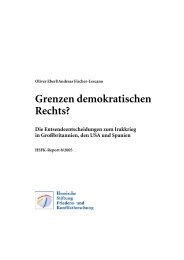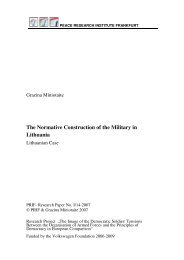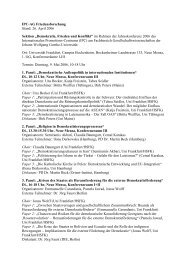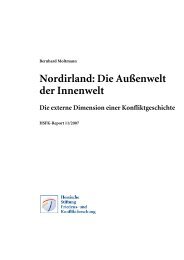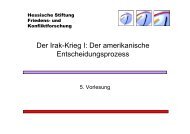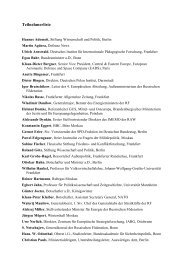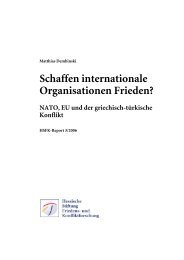From Exodus to Exitus Causes of post-war violence in El ... - eDoc
From Exodus to Exitus Causes of post-war violence in El ... - eDoc
From Exodus to Exitus Causes of post-war violence in El ... - eDoc
Create successful ePaper yourself
Turn your PDF publications into a flip-book with our unique Google optimized e-Paper software.
12 Heidrun Z<strong>in</strong>ecker<br />
dom<strong>in</strong>ated the country for centuries cont<strong>in</strong>ues <strong>to</strong> hold sway <strong>in</strong> <strong>El</strong> Salvador. S<strong>in</strong>ce the end<br />
<strong>of</strong> the civil <strong>war</strong> this nucleus has modernized itself, taken on a global dimension and diversified<br />
its activities. Further power groups have sprung up around it, some <strong>of</strong> which are its<br />
economic equals. Even its own most significant <strong>in</strong>come is no longer from c<strong>of</strong>fee but from<br />
new, speculative, s<strong>to</strong>cks and bonds. After the peace agreement, the most important c<strong>of</strong>fee<br />
oligarchies concentrated their efforts <strong>in</strong> the sec<strong>to</strong>r <strong>of</strong> f<strong>in</strong>ancial speculation. Later on they<br />
expanded their bus<strong>in</strong>ess <strong>in</strong><strong>to</strong> provision for the elderly, <strong>in</strong>surance and real estate (Segovia<br />
2006: 549). As it was only a few families (<strong>in</strong> particular Cristiani-Burkard-Llach-Hill,<br />
Mathies-Regalado-Dueñas-Baldocchi, Murray-Meza-Ayau and de Sola) who expanded<br />
their former bus<strong>in</strong>ess activities <strong>in</strong> the c<strong>of</strong>fee monopoly <strong>in</strong><strong>to</strong> other sec<strong>to</strong>rs, namely the f<strong>in</strong>ancial<br />
sec<strong>to</strong>r, the Salvadoran rent-appropriat<strong>in</strong>g class while admittedly moderniz<strong>in</strong>g<br />
itself did not s<strong>to</strong>p be<strong>in</strong>g an oligarchy, but merely restructured itself as a new oligarchy.<br />
Nevertheless <strong>El</strong> Salvador has the lowest G<strong>in</strong>i coefficient after Costa Rica and therefore<br />
a relatively low level <strong>of</strong> general <strong>in</strong>equality by Central American standards. This is due<br />
ma<strong>in</strong>ly <strong>to</strong> the fact that the second, third and fourth qu<strong>in</strong>tiles from the lowest are relatively<br />
well <strong>of</strong>f, as illustrated <strong>in</strong> Figure 2. This is also borne out by the high level <strong>of</strong> migration by<br />
Hondurans and Nicaraguans <strong>to</strong> <strong>El</strong> Salvador because <strong>of</strong> the higher wages there.<br />
Figure 2: Income distribution by qu<strong>in</strong>tile <strong>in</strong> urban households, 1998/1999<br />
1st qu<strong>in</strong>tile 2nd qu<strong>in</strong>tile 3rd qu<strong>in</strong>tile 4th qu<strong>in</strong>tile 5th qu<strong>in</strong>tile<br />
<strong>El</strong> Salvador 5.6 10.7 15.7 22.5 45.6<br />
Guatemala 5.5 9.2 15.5 19.7 62.2<br />
Honduras 4.7 9.7 13.5 21.2 49.8<br />
Nicaragua 3.5 8.8 13.3 20.2 54.3<br />
Costa Rica 5.5 10.6 15.9 24.1 43.8<br />
Source: UNDP 2004: 129f.<br />
The rent-appropriat<strong>in</strong>g oligarchy as the <strong>to</strong>p qu<strong>in</strong>tile implies not only marg<strong>in</strong>ality at the<br />
other end <strong>of</strong> the scale, the lowest qu<strong>in</strong>tile, but also has no <strong>in</strong>terest <strong>in</strong> free market economy<br />
or the prerequisite for this, the production <strong>of</strong> capital goods. It generally <strong>in</strong>vests very little<br />
<strong>in</strong> the production sec<strong>to</strong>r. Investment rates reflect this: between 1990 and 2003 <strong>in</strong> <strong>El</strong> Salvador,<br />
with its high level <strong>of</strong> <strong>violence</strong>, fixed <strong>in</strong>ternal gross <strong>in</strong>vestment was 16.6 % <strong>of</strong> its GDP,<br />
rank<strong>in</strong>g the country n<strong>in</strong>e percentage po<strong>in</strong>ts below Nicaragua, with its low level <strong>of</strong> <strong>violence</strong>,<br />
<strong>in</strong> which it was 25.6 po<strong>in</strong>ts. 7<br />
Under conditions where oligarchic structures systematically obstruct <strong>in</strong>vestments – especially<br />
<strong>in</strong> capital goods production – and therefore also local production and labour, the<br />
oligarchy urgently needs an outlet <strong>in</strong> order <strong>to</strong> survive. New rents fulfil this function. However,<br />
new rents for their part restrict the firm establishment <strong>of</strong> local labour and production,<br />
which once more attracts a low level <strong>of</strong> <strong>in</strong>vestment. The most important new rents <strong>in</strong><br />
7 cf. www.eclac.org/publicaciones/xml/0/14980/DGE-2234-Cap3.pdf (last accessed 02.05.07).





